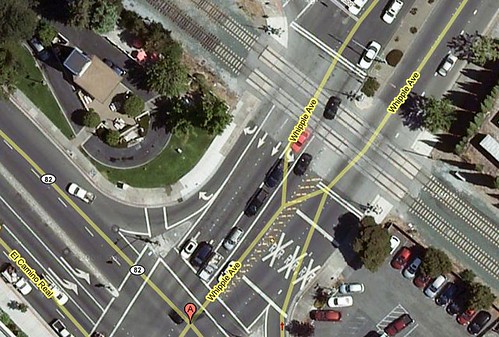There was a horrific incident earlier this month, widely reported, in which a man was struck and killed in his car by a speeding commuter train in Redwood City. Chuck Isaacson, a 64-year-old Santa Clara County employee and Redwood City resident, was driving his Honda Civic westbound on Whipple Avenue. Just as he was crossing the Caltrain tracks, the cars ahead of him unexpectedly stopped to yield to a fire engine racing down El Camino Real with its sirens and flashers on. At that moment the train crossing arms lowered and Isaacson’s car was trapped on the tracks by the cars around him. 30 seconds later a southbound train struck his car, killing him instantly.
As fate would have it Caltrain had proclaimed September “Rail Safety Month” so it’s fitting to examine what happened and learn what we can from it.
First, it’s good to keep in mind just how close El Camino Real and the Caltrain tracks are, particularly in San Mateo County. At Whipple they’re only about 40 yards apart, enough room for just five car lengths. This is unsurprising since historically El Camino was the route that connected the early metropolitan centers of San Jose and San Francisco. A railway line between the two was first proposed in 1851 and regular service commenced in 1863. It only made sense for the train tracks to follow El Camino since it was a proven route, and the easy access they both provided contributed to the expansion of all the cities along the Peninsula.
A controversial point is the fact that so many of the Caltrain intersections are at-grade meaning cars cross the tracks at the same level as the trains without benefit of over- or underpasses. (A notable exception is the underpass at Hillsdale Blvd in San Mateo.) No doubt it would have been a tremendous and expensive undertaking to remedy these dangerous junctions, but clearly it was the grade crossing that put Mr. Isaacson in peril.
The combination of El Camino with all its traffic, all the intersecting arterials, and Caltrain trains that can’t stop can result in a number of unforeseeable scenarios that could stump even seasoned traffic engineers. For example the light at Whipple and El Camino may well have been green but the cars were stopped by the de jure red lights on the fire engine.
Caltrain offers a number of safety tips for navigating its crossings. This one is most pertinent to Mr. Isaacson’s case:
Never drive onto a railroad crossing until you are sure the traffic ahead has left enough space to drive across without boxing you in. Do not shift gears while driving across the tracks. If your vehicle stalls on the crossing get everyone out and get off the tracks. Call 911 or 1.877.SAF.RAIL (1.877.723.7245) to report the situation.
I can only imagine that being stuck on tracks with a train oncoming must feel surreal but as in all crises it’s important to stay calm, think clearly, and act quickly. The Mercury News puts it bluntly…flee or die:
But for motorists who find themselves in the same scenario as Isaacson, experts offered this simple advice: Get out of the car and run.
Those who must escape their vehicles should run at an angle [not on the tracks! -Bill] in the direction toward the train, said Virginia-based rail safety expert Danny Gilbert.
While that may sound completely counterintuitive, he said, running at the train keeps you out of harm’s way.
When the train hits the car it will go flying. If you run in the same direction that the train is going, you will be in the trajectory of the car or any flying debris produced by the collision, he said.
Mr. Isaacson’s death is a tragedy. While it’s little comfort to his family and friends, hopefully his passing will underscore these important safety lessons so that other lives may be saved.
